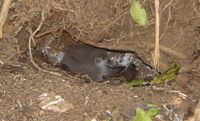|
Shearwaters |

Audubon's Shearwater chick
|
|
Scientific classification |
| Kingdom: |
Animalia
|
| Phylum: |
Chordata
|
| Class: |
Aves
|
| Order: |
Procellariiformes
|
| Family: |
Procellariidae
|
|
| Genera |
Procellaria
Calonectris
Puffinus |
Shearwaters are medium-sized long-winged
seabirds. There are more than 25
species of shearwaters, four large species in the
genus Procellaria, three large species in the genus
Calonectris, and 19 mostly smaller species in the genus
Puffinus. Those in Procellaria are usually called "petrel",
though they are thought to be more closely to the
shearwaters than to the other petrels.
These birds are most common in temperate and cold waters.
They are
pelagic outside the breeding season.
These
tubenose birds fly with stiff wings, and use a “shearing”
flight technique to move across wave fronts with the minimum
of active flight. Some small species, like Manx Shearwater are cruciform in flight, with their long
wing held directly out from their bodies.
Many are long-distance migrants, perhaps most
spectacularly
Sooty Shearwaters, which cover distances in excess of 14,000
km from their breeding colony on the Falkland Islands (52°S
60°W) north to 65°-70°N in the North Atlantic Ocean off
north Norway. Short-tailed Shearwaters perform an even
longer "figure of 8" loop migration in the Pacific Ocean
from Tasmania to as far north as the Arctic Ocean off
northwest Alaska.
They are also extraordinarily long-lived. A Manx
Shearwater breeding on Copeland Island, Northern Ireland, is
currently (2003/2004) the oldest known wild bird in the
world: ringed as an adult (at least 5 years old) in July
1953, it was retrapped in July 2003, at least 55 years old.
Manx Shearwaters migrate over 10,000 km to South America in
winter, using waters off southern Brazil and Argentina, so this bird has covered a minimum of
1,000,000 km on migration alone.
Shearwaters come to islands and coastal cliffs only to
breed. They are nocturnal at the colonial breeding sites,
preferring moonless nights. This is to minimise predation.
They nest in burrows and often give eerie contact calls on
their nighttime visits. They lay a single white egg.
They feed on fish, squid and similar oceanic food. Some
will follow fishing boats to take scraps, notably Sooty
Shearwater; these species also commonly follow
whales to feed on fish disturbed by them.
Shearwaters are part of the
family
Procellariidae, which also includes fulmars, prions and
petrels.
The
Sibley-Ahlquist taxonomy gives a radically different
scientific arrangement for this group based on DNA
studies.
List of species
- Genus
Procellaria
- Grey Petrel, P. cinerea
White-chinned Petrel, P. aequinoctialis
Black Petrel, P. parkinsoni
Westland Petrel, P. westlandica
- Genus
Calonectris
- Streaked Shearwater, C. leucomelas
Cory's Shearwater, C. diomedea
Cape Verde Shearwater, C. edwardsii
- Genus
Puffinus
- Wedge-tailed Shearwater, P. pacificus
Buller's Shearwater, P. bulleri
Flesh-footed Shearwater, P. carneipes
Pink-footed shearwater, P. creatopus
Great Shearwater, P. gravis
Sooty Shearwater, P. griseus
Short-tailed Shearwater or Mutton bird, P.
tenuirostris
Heinroth's Shearwater, P. heinrothi
Christmas Shearwater, P. nativatis
Fluttering Shearwater, P. gavia
Hutton's Shearwater, P. huttoni
Manx Shearwater, P. puffinus
Yelkouan Shearwater, P. yelkouan
Balearic Shearwater, P. mauretanicus
Black-vented Shearwater, P. opisthomelas
Townsend's Shearwater, P. auriculatus
Hawaiian Shearwater, P. newelli
Audubon's Shearwater, P. lherminieri
North Atlantic Little Shearwater P. baroli
Little Shearwater, P. assimilis
External links




